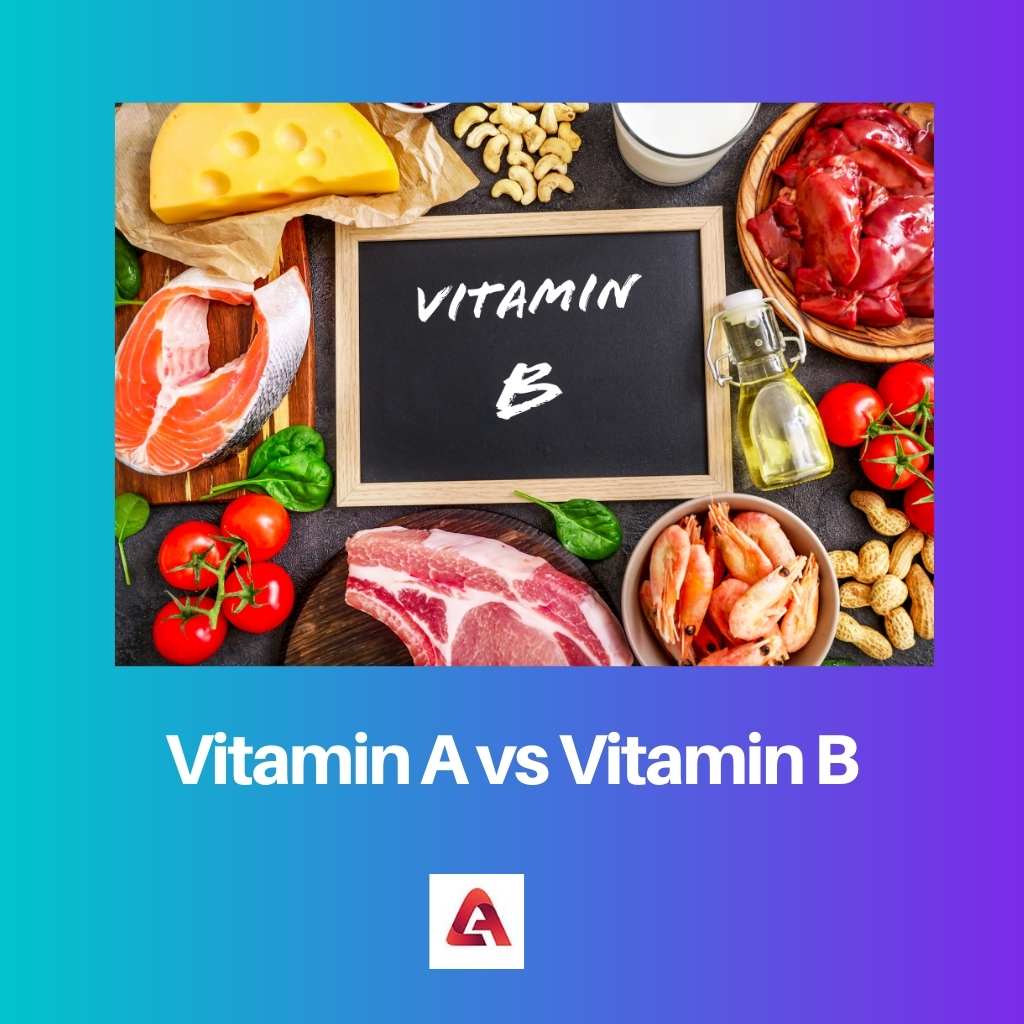Our body needs food and water so that it can take up nutrition from them. Nutrients are required to carry out all the several different processes and chemical reactions that are occurring in the body.
Nutrients are classified into several types, such as minerals, vitamins, fats, carbohydrates, proteins, and more. These nutrients are further classified into different types. Vitamin A and Vitamin B are two such further classifications of the nutrient vitamin.
Key Takeaways
- Vitamin A is a fat-soluble vitamin essential for vision, immune function, and reproduction.
- Vitamin B represents a group of water-soluble vitamins playing crucial roles in cell metabolism and energy production.
- Both vitamins are necessary for maintaining overall health, but they serve different biological functions and have different food sources.
Vitamin A vs Vitamin B
Vitamin A is a fat-soluble vitamin needed to improve the night vision of the human body. Vitamin A can be extracted from green leafy vegetables, including spinach, broccoli, etc. Vitamin B is water-soluble and is found in dairy products like eggs, milk, etc. It is important for cell growth, etc.

Vitamin A is a very important type of vitamin that the human body needs to perform certain functions. Some of the diseases caused due to the deficiency of vitamin A could be celiac disease, giardiasis, cirrhosis, bile duct disorder, and more.
The other common name of Vitamin A is retinol.
Vitamin B is a type of water-soluble vitamin that plays a major role in the body’s metabolic process. Some of the other major functions of vitamin B are maintaining cell health, improving the growth of red blood cells, improving eyesight, ensuring better digestion of food, and healthy functioning of the mind.
Comparison Table
| Parameters of comparison | Vitamin A | Vitamin B |
|---|---|---|
| Type | Vitamin A is a fat-soluble vitamin. | Vitamin B is a water-soluble vitamin. |
| Classifications | Vitamin A is further divided into 2 different types. | Vitamin B is further classified into 8 different types. |
| Source | Vitamin A is majorly found in leafy and green vegetables such as spinach, broccoli, and carrots. | B vitamins are found majorly in dairy products such as milk, eggs, cheese, and animal products such as meat, fish, shellfish. |
| Deficiency | The most common health problem caused due to deficiency of vitamin A is night blindness. | The most common health problem caused due to deficiency of vitamin B is night anemia. |
| Function | The main function of vitamin A is to improve or maintain good night vision. | The most common function of vitamin B is to improve cell functioning in the body. |
What is Vitamin A?
Vitamin A can be classified into 2 different types of categories depending upon from which source the vitamin is extracted. The two types of vitamins are retinol and carotenoids. Vitamin A can be found in both types of sources, that are, plants and animals.
If vitamin A is sourced from an animal source, it is then known as retinol. On the other hand, if vitamin A is sourced from a plant source, it is then known as a carotenoid.
Vitamin A plays a major role in the stimulation and healthy functioning of the white blood cells, and it regulates cell growth in the body, keeps the body’s immune system active, and more.
Apart from that, vitamin A also plays a great role in improving a person’s night vision. The reason is that when consumed, vitamin A further binds with a certain chemical in the body.
The bonding of vitamin A with the chemical produces a product known as rhodopsin. The functionality of rhodopsin is to stimulate rods present in the eye, which are responsible for vision in the dark.
A deficiency of vitamin A can cause several different health problems, most common problem is night blindness and other eye problems as well, such as dry eyes or patches in the white region of the eye.
What is Vitamin B?
Vitamin B is important, especially for pregnant or breastfeeding women. The B vitamins improve the overall body and mind development of the fetus during pregnancy.
Moreover, it also reduces the chances of birth defects in the child. Not just for the fetus but it is also important for the mothers. Thus, B vitamins are given to pregnant women as a supplement.
Vitamin B is further divided into 8 different types of vitamins. The classification is done based on the chemical structure of the B vitamins.
Since the chemical structure of all the B vitamins changes, their chemical composition changes, and as a result, their functions also change.
Thus, all 8 different types of B vitamins have different functions, and their deficiency or excess can cause different health problems.
The 8 types of B vitamins are vitamin B1, also known as thiamine, vitamin B2, also known as riboflavin, vitamin B3, also known as niacin or nicotinamide, vitamin B5 or pantothenic acid, vitamin B6 or pyridoxine, pyridoxal, pyridoxamine, vitamin B7 or biotin, vitamin B9 or folate, and vitamin B12 or cobalamins.
The dietary supplements which include all 8 different types of vitamins are known as vitamin complex.
Main Differences Between Vitamin A and Vitamin B
- Vitamin A is further classified depending on its source. In contrast, vitamin B is classified depending on the chemical structures.
- The recommended dietary supplement for vitamin A is about 700 mcg to 900 mcg. On the other hand, the recommended dietary supplement for B vitamins varies depending upon the type of B vitamin.
- The toxicity of vitamin A can cause skin damage. Whereas, the toxicity of vitamin B can cause neurological damage.
- Vitamin A supplements are commonly used for the eyes and skin. On the other hand, vitamin B supplements are commonly used by pregnant women.
- Vitamin A is stored in the fats of the body. On the contrary, vitamin B is stored in the liver.

